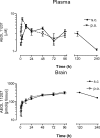An orally active catalytic metalloporphyrin protects against 1-methyl-4-phenyl-1,2,3,6-tetrahydropyridine neurotoxicity in vivo
- PMID: 17442816
- PMCID: PMC6672309
- DOI: 10.1523/JNEUROSCI.0019-07.2007
An orally active catalytic metalloporphyrin protects against 1-methyl-4-phenyl-1,2,3,6-tetrahydropyridine neurotoxicity in vivo
Abstract
Parkinson's disease (PD) is an age-related neurodegenerative disease in which the role of reactive oxygen species (ROS) is strongly implicated. The presence of oxidative stress has been detected in human and experimental PD using both direct and indirect indices. Scavenging ROS is, therefore, an important therapeutic avenue for the treatment of PD. Manganic porphyrins are catalytic antioxidants that scavenge a wide range of ROS. In this study, we tested the therapeutic effects of a compound [5,15-bis(methoxycarbonyl)-10,20-bis-trifluoromethyl-porphyrinato manganese (III) chloride (AEOL11207)] belonging to a new generation of lipophilic manganic porphyrins for neuroprotection and oral bioavailability in the mouse 1-methyl-4-phenyl-1,2,3,6-tetrahydropyridine (MPTP) model of parkinsonism. Groups of adult C57BL/6 mice were administered MPTP with varying subcutaneous or oral dosing regimens of AEOL11207. Neurotoxicity was assessed by measurement of striatal dopamine levels and quantification of tyrosine hydroxylase-positive neurons in the substantial nigra pars compacta one week after the first dose of MPTP. Glutathione depletion, lipid peroxidation, and 3-nitrotyrosine (3-NT) formation were measured as indicators of oxidative stress in the ventral midbrain in vivo. AEOL11207 administered either by subcutaneous or oral routes protected against MPTP-induced dopamine depletion in the striatum as well as dopaminergic neuronal loss, glutathione depletion, lipid peroxidation, and 3-NT formation in the ventral midbrain. Neuroprotection correlated with brain metalloporphyrin concentrations. This is the first demonstration of neuroprotection by an orally active catalytic antioxidant in the MPTP mouse model and suggests its potential clinical utility for the treatment of chronic neurodegenerative diseases such as PD.
Figures






Similar articles
-
Pre-clinical therapeutic development of a series of metalloporphyrins for Parkinson's disease.Toxicol Appl Pharmacol. 2017 Jul 1;326:34-42. doi: 10.1016/j.taap.2017.04.004. Epub 2017 Apr 8. Toxicol Appl Pharmacol. 2017. PMID: 28400118 Free PMC article.
-
EGb761 protects against nigrostriatal dopaminergic neurotoxicity in 1-methyl-4-phenyl-1,2,3,6-tetrahydropyridine-induced Parkinsonism in mice: role of oxidative stress.Eur J Neurosci. 2008 Jul;28(1):41-50. doi: 10.1111/j.1460-9568.2008.06314.x. Eur J Neurosci. 2008. PMID: 18662333
-
Optimization of Lipophilic Metalloporphyrins Modifies Disease Outcomes in a Rat Model of Parkinsonism.J Pharmacol Exp Ther. 2021 Apr;377(1):1-10. doi: 10.1124/jpet.120.000229. Epub 2021 Jan 26. J Pharmacol Exp Ther. 2021. PMID: 33500265
-
The intranasal administration of 1-methyl-4-phenyl-1,2,3,6-tetrahydropyridine (MPTP): a new rodent model to test palliative and neuroprotective agents for Parkinson's disease.Curr Pharm Des. 2011;17(5):489-507. doi: 10.2174/138161211795164095. Curr Pharm Des. 2011. PMID: 21375482 Review.
-
Metallothionein-mediated neuroprotection in genetically engineered mouse models of Parkinson's disease.Brain Res Mol Brain Res. 2005 Mar 24;134(1):67-75. doi: 10.1016/j.molbrainres.2004.09.011. Brain Res Mol Brain Res. 2005. PMID: 15790531 Free PMC article. Review.
Cited by
-
The antioxidative effect of electro-acupuncture in a mouse model of Parkinson's disease.PLoS One. 2011;6(5):e19790. doi: 10.1371/journal.pone.0019790. Epub 2011 May 23. PLoS One. 2011. PMID: 21625423 Free PMC article.
-
Design, mechanism of action, bioavailability and therapeutic effects of mn porphyrin-based redox modulators.Med Princ Pract. 2013;22(2):103-30. doi: 10.1159/000341715. Epub 2012 Oct 16. Med Princ Pract. 2013. PMID: 23075911 Free PMC article. Review.
-
Novel Catalytic Antioxidant Formulation Decreases Oxidative Stress, Neuroinflammation and Cognitive Dysfunction in a Model of Nerve Agent Intoxication.J Pharmacol Exp Ther. 2024 Jan 17;388(2):358-366. doi: 10.1124/jpet.123.001708. J Pharmacol Exp Ther. 2024. PMID: 37652711 Free PMC article.
-
Antioxidants in central nervous system diseases: preclinical promise and translational challenges.J Alzheimers Dis. 2008 Nov;15(3):473-93. doi: 10.3233/jad-2008-15314. J Alzheimers Dis. 2008. PMID: 18997301 Free PMC article. Review.
-
Therapeutic approach to neurodegenerative diseases by medical gases: focusing on redox signaling and related antioxidant enzymes.Oxid Med Cell Longev. 2012;2012:324256. doi: 10.1155/2012/324256. Epub 2012 Jul 1. Oxid Med Cell Longev. 2012. PMID: 22811764 Free PMC article. Review.
References
-
- Alam ZI, Jenner A, Daniel SE, Lees AJ, Cairns N, Marsden CD, Jenner P, Halliwell B. Oxidative DNA damage in the parkinsonian brain: an apparent selective increase in 8-hydroxyguanine levels in substantia nigra. J Neurochem. 1997a;69:1196–1203. - PubMed
-
- Alam ZI, Daniel SE, Lees AJ, Marsden DC, Jenner P, Halliwell B. A generalised increase in protein carbonyls in the brain in Parkinson's but not incidental Lewy body disease. J Neurochem. 1997b;69:1326–1329. - PubMed
-
- Bannon MJ, Goedert M, Williams B. The possible relation of glutathione, melanin and 1-methyl-4-phenyl-1,2,5,6-tetrahydropyridine (MPTP) to Parkinson's disease. Biochem Pharmacol. 1984;33:2697–2698. - PubMed
-
- Beal MF. Mitochondrial dysfunction in neurodegenerative diseases. Biochim Biophys Acta. 1998;1366:211–223. - PubMed
Publication types
MeSH terms
Substances
Grants and funding
LinkOut - more resources
Full Text Sources
Other Literature Sources
Medical
Research Materials
Miscellaneous
